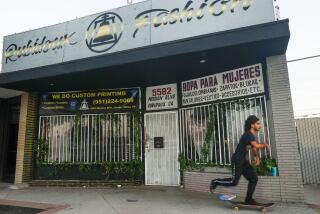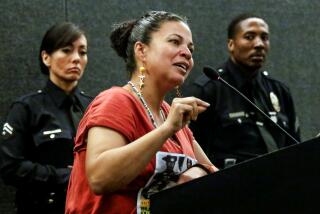Survivors of Attacks Face Second Hurdle: Fear : Violence: Severe injury may be only a fraction of the ordeal. Trauma to the personality may never heal.
WASHINGTON â People stare at the scars on his throat as he waits in the market checkout line. Sometimes strangers ask him if he has a cold; sometimes they ask if he fought in Vietnam.
He never served in Vietnam, but he says yes, he did, because he knows from past experience that they wonât want to hear how he got the scars.
The truth is that, eight years ago, a stranger jammed a knife into his gut, spilling the intestines out of his slight frame, then slit his throat as he lay calling for help. Itâs those details that people donât want to hear of--details that still rattle him, still cause his hands to shake uncontrollably, hands with nails bitten down to nothing.
The sandy-haired young father is just one of several million people who have been victims of aggravated assaults in the last 10 years.
The attack swept away his optimism and trust in others, his devil-may-care attitude. Left instead is fear--fear so real that after telling his story, he asked that his real name and that of his hometown be withheld.
âWe live with the realization that it doesnât happen to somebody else,â said the boyish, 33-year-old weâll call Larry Roberts. âWe know that people will hurt you.â
Murders may steal the headlines, but the number of serious nonfatal assaults dwarfs the number of killings. Assault victims survive, but often they are changed forever.
âThe trauma of having looked at the jaws of death is something that is very rough to deal with,â said John Stein, deputy director of the National Organization for Victims Assistance.
Some 559,270 people--roughly the population of Columbus, Ohio--were injured in aggravated assaults last year alone, according to the National Crime Survey, which annually interviews members of some 49,000 households to extrapolate nationwide figures.
The survey found that 1.1 million others were the targets of attempted assaults with a weapon--were shot at and missed, for example.
On the night of June 6, 1982, Roberts was on leave from the Navy. He was interested mainly in getting in one last day of scuba diving before his aircraft carrier departed in two days.
He was pitching a tent in a park when two strangers approached and struck up a conversation with him. They seemed friendly enough.
Then, without warning, one of them stabbed Roberts in the abdomen and ran off with his scuba gear, wedding ring and $4.
âWhen I thought he was gone, I started to holler for help,â Roberts said with a catch in his now-raspy voice. âHe came back through the woods and he tilted my head back and slit my throat twice. And then he tied my feet together and my hands back to two trees.â
Roberts eventually worked free, dragged and himself about 250 feet to a dirt road, holding in his intestines and pressing his chin downward to keep the blood from spurting out. Help finally arrived the next morning.
He spent 10 months in a hospital and had at least 10 operations.
The fear took over when he emerged from the hospital on April 18, 1983.
âI used to take a gun with me wherever I went,â he said. âI was scared to death.â
In the next two years, Roberts moved his family six times.
âSomething would happen, something would trigger me and weâd be gone,â he said.
They stopped running five years ago in rural Maryland so that their elder daughter could start school and enjoy a semblance of a normal life. Four years ago, Roberts and his wife had a second daughter.
In the meantime, his attacker pleaded guilty to attempted murder and sentenced to 10 years in prison. He served six years, then was released as a model prisoner.
Roberts still fears him--even though he believes his fear is irrational. (He also insisted that the assailantâs name not be used, in part because he doesnât want to antagonize him.)
Even now, Robertsâ home is guarded by a large, loud watchdog named Norad, after the national early-warning system for nuclear attacks. At night, the house is awash in light. Two sheriffâs deputies live across the street.
Roberts and his wife never employ baby-sitters because they donât trust strangers.
The attack destroyed Robertsâ career plans. The Navy discharged him because he could no longer perform his job.
Desperate to make up for lost time, Roberts pushed himself too hard. He has had a drinking problem. He spent two months in a psychiatric hospital last year.
Today, he takes things more slowly. He teaches diving part time while attending college.
And after years of shying away from the world, he now tells his story to police groups. He hopes to make the officers sensitive to crime victimsâ needs.
âThe victim is a piece of evidence,â said Andrew Turner, a criminal justice instructor at Wor Wic Tech Community College and a former Maryland police officer who has arranged some of Robertsâ talks.
âIf the guy survived, you had a good case. He could come and testify against the perpetrator.â Turner said. âPolice donât see a guy healed upâ yet still in need of emotional support.
Roberts finds telling his story therapeutic, despite the toll it takes. He has established a network of people who can help him when he cracks from the strain.
It is important to Roberts that he controls the impact of the attack, not the other way around, but he conceded: âIt has given my life a different direction.â
He has yet another fear: AIDS.
Roberts had numerous blood transfusions in 1982, before donated blood could be screened for the deadly disease. He refuses to be tested for AIDS now.
âIf Iâm going to die of it,â he said with a grimace, âI donât want to know about it.â
More to Read
Sign up for Essential California
The most important California stories and recommendations in your inbox every morning.
You may occasionally receive promotional content from the Los Angeles Times.










